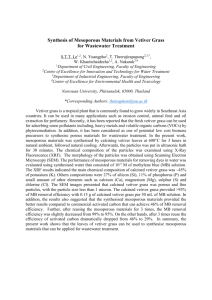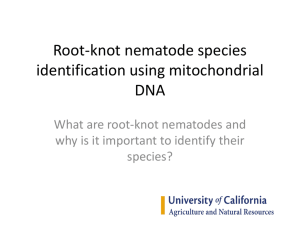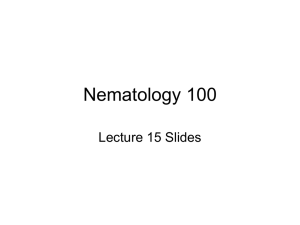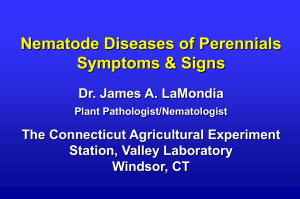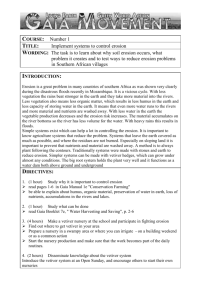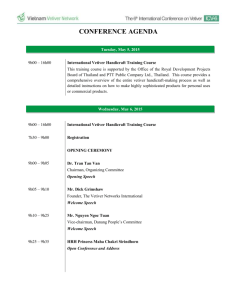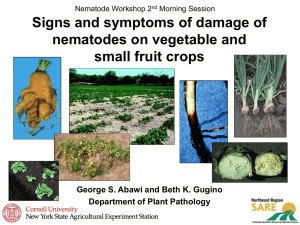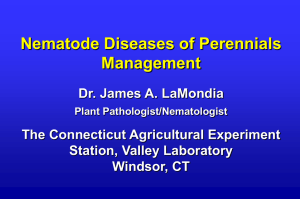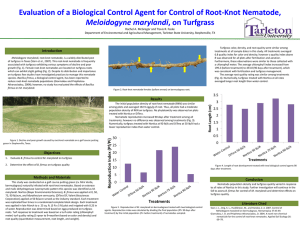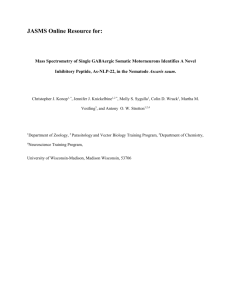rkn (mel. spp) are aquatic, wormlike, multicellular animals. The
advertisement
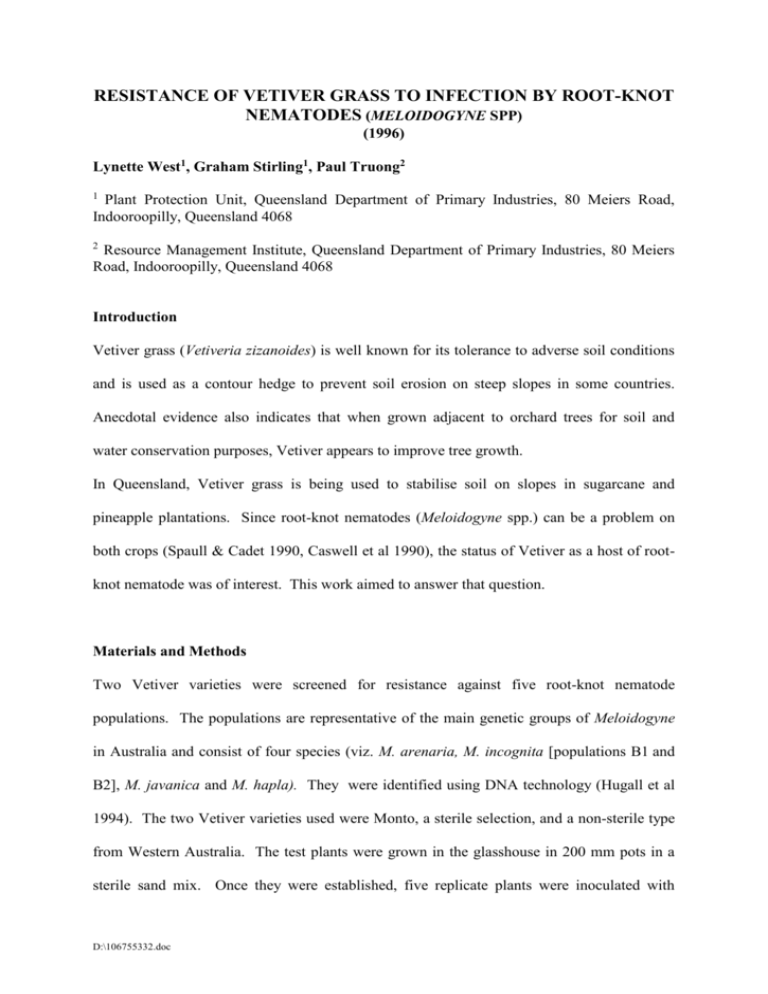
RESISTANCE OF VETIVER GRASS TO INFECTION BY ROOT-KNOT NEMATODES (MELOIDOGYNE SPP) (1996) Lynette West1, Graham Stirling1, Paul Truong2 1 Plant Protection Unit, Queensland Department of Primary Industries, 80 Meiers Road, Indooroopilly, Queensland 4068 2 Resource Management Institute, Queensland Department of Primary Industries, 80 Meiers Road, Indooroopilly, Queensland 4068 Introduction Vetiver grass (Vetiveria zizanoides) is well known for its tolerance to adverse soil conditions and is used as a contour hedge to prevent soil erosion on steep slopes in some countries. Anecdotal evidence also indicates that when grown adjacent to orchard trees for soil and water conservation purposes, Vetiver appears to improve tree growth. In Queensland, Vetiver grass is being used to stabilise soil on slopes in sugarcane and pineapple plantations. Since root-knot nematodes (Meloidogyne spp.) can be a problem on both crops (Spaull & Cadet 1990, Caswell et al 1990), the status of Vetiver as a host of rootknot nematode was of interest. This work aimed to answer that question. Materials and Methods Two Vetiver varieties were screened for resistance against five root-knot nematode populations. The populations are representative of the main genetic groups of Meloidogyne in Australia and consist of four species (viz. M. arenaria, M. incognita [populations B1 and B2], M. javanica and M. hapla). They were identified using DNA technology (Hugall et al 1994). The two Vetiver varieties used were Monto, a sterile selection, and a non-sterile type from Western Australia. The test plants were grown in the glasshouse in 200 mm pots in a sterile sand mix. Once they were established, five replicate plants were inoculated with D:\106755332.doc 10,000 root-knot nematode eggs. A susceptible tomato cultivar (cv. Tiny Tim) was used as a standard for comparative purposes. Plants were harvested 6 weeks after inoculation, when egg masses on tomatoes were mature. Roots washed free of soil were immersed in a 1% NaOCl solution for three minutes and eggs were collected on a 38m sieve and counted. Results and Discussion Both Vetiver varieties were highly resistant to all five root-knot nematode populations. Reproduction was approximately 1000-fold less than on the susceptible tomato (Table 1). Vetiver also compared favourably with other grasses that have been found to be resistant to root-knot nematode in similar tests (Table 2).Our results confirmed those of de Moura et al (1990) who found that Vetiver was “immune” to both M. incognita race 1 and M. javanica. Conclusion Since the grass was resistant to all major species of Meloidogyne, Vetiver is unlikely to exacerbate problems caused by root-knot nematodes when used as a cover, companion or hedgerow crop. Table 1 Vetiver cultivar Monto WA Tomato Mean number of eggs produced per plant when five populations of Meloidogyne were inoculated onto Vetiveria zizanoides Meloidogyne populations Ma %* Mi (B1) %* Mi (B2) %* Mj %* Mh %* 489 147 310110 0.16 0.05 238 15 274245 0.09 0.01 70 17 25228 0.28 0.07 1343 410 296100 0.45 0.14 464 23 105930 0.44 0.02 *Indicates the resistance status, determined by the number of eggs produced as a percentage of the number of eggs on tomato. 2 Table 2 Status of various grasses as hosts of root-knot nematodes, as indicated by the number of eggs produced on the grass as a percentage of the number of eggs on tomato. Meloidogyne populations M. arenaria M. incognita (B1) M. javanica Susceptible Maize:cv. FSS cv.Hycorn 82 cv.SSC 38 Moderately Resistant Maize:cv. H5 cv. XL80 Setaria:cv. Narok cv. Solander Panorama millet Resistant Forage sorghum:cv. Jumbo Rhodes grass:cv. Callide cv. Nemkat Pangola grass Panic:cv. Gatton Panic cv. Riversdale Guinea Vetiver grass:cv. Monto cv. WA - 34.1 24.7 24.0 26.5 58.6 11.4 - 4.9 1.9 9.1 0.1 8.3 2.1 6.4 2.7 0.5 3.0 0.8 1.7 2.9 0.00 0.08 0.00 0.32 0.01 0.34 0.09 0.01 1.22 0.07 0.00 0.04 0.00 0.01 0.03 0.00 0.01 0.36 0.16 0.05 0.09 0.01 0.45 0.14 3 References Caswell, E.P., Sarah, J-L. and Apt, W.J. (1990) Nematode parasites of pineapple. In Plant parasitic nematodes in subtropical and tropical agriculture (Eds M. Luc, R.A. Sikora and J. Bridge), CAB International, London. de Moura, R.M., de Oliveira-Regis, E.M. & de Moura, A.M. (1990) Reactions of ten plant species, some producers of essential oils, in relation to Meloidogyne incognita race 1 and M. javanica parasitism in mixed population. Nematologia Brasileira 14 : 39-44. Hugall, A., Moritz, C., Stanton, J. and Wolstenholme, D.R. (1994) Low, but strongly structured mitochondrial DNA diversity in root knot nematodes(Meloidogyne). Genetics 136 : 903-912. Spaull, V.W. and Cadet, P. (1990) Nematode parasites of sugarcane. In Plant parasitic nematodes in subtropical and tropical agriculture, (Eds M. Luc, R.A. Sikora and J. Bridge), CAB International, London. 4
